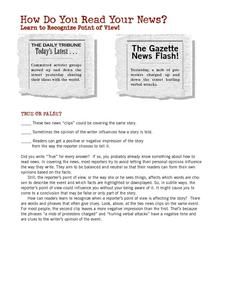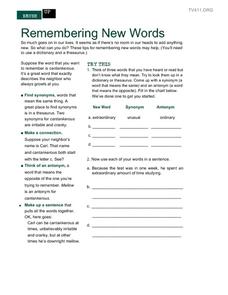TV411
Dependent and Independent Clauses Join Forces
Young grammarians are often confused by clauses, especially the difference between dependent and independent clauses. Clarify the confusion with a color-coded worksheet that clearly defines and illustrates the differences and then gives...
TV411
Avoid Mushy Writing: Be Specific
Replacing, bland, inexact generalizations with specific statement and precise information is the focus of a worksheet that models how to transform general statements into specific ones. After examining four models, learners have an...
TV411
How Do You Read Your News?
Words carry baggage. Class members are asked to consider the weight of words in an exercise that contrasts the word choices in two versions of the same event. Consider following the exercise with an activity in which pairs craft positive...
TV411
Remembering New Words
Four strategies learners can use to remember new words are detailed on a one-page worksheet. They are shown how to find synonyms, make a personal connection, think of antonyms, and how to make up a sentence that puts the words together....
TV411
Understanding Hard Words
Two strategies for decoding unfamiliar words are featured on a worksheet that illustrates how to use the parts of words (prefix, root, and suffix) and context to determine meaning. Examples are included as is a guided practice exercise.
TV411
Learn the Steps to Clear Essay Writing!
Introduce your young writers to the five-paragraph expository essay format with a four-page worksheet that uses color codes to model for writers how to craft the essay. Although designed to prepare writers for the GED, the approach can...
TV411
How Many Languages Do You Speak When You Speak English?
What do the words pizza, broccoli, and ciao have in common? Why they are all English words that originally came from Italian. Ask your middle schoolers to guess the origins of a list of words by matching the word with the language from...
TV411
Whip up a Storm of Writing Ideas
Need a key to unlock writer's block? Introduce your writers to four easy steps that will release them from their mental prison. The brainstorming worksheet, designed to set free their imaginations, even has an answer key.









